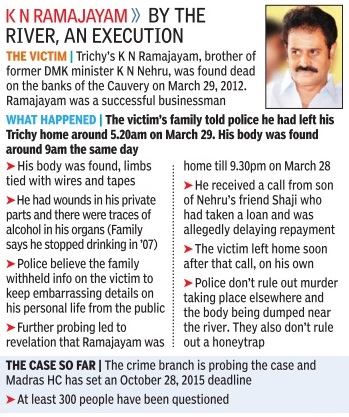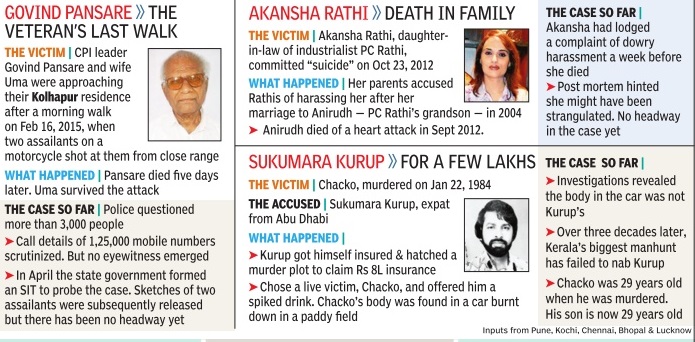Murders: India
(→1957-2016) |
(→Causes) |
||
| Line 11: | Line 11: | ||
=Causes= | =Causes= | ||
| + | ==2001-17: Vendetta, land and love== | ||
| + | [https://epaper.timesgroup.com/Olive/ODN/TimesOfIndia/shared/ShowArticle.aspx?doc=TOIDEL%2F2019%2F11%2F17&entity=Ar00316&sk=1D713899&mode=text Atul Thakur, Additional reporting by Himanshi Dhawan, Nov 17, 2019: ''The Times of India''] | ||
| + | |||
| + | [[File: Reasons why people commit murders in India, state-wise, 2017.jpg| Reasons why people commit murders in India, state-wise, 2001-17 <br/> From: [https://epaper.timesgroup.com/Olive/ODN/TimesOfIndia/shared/ShowArticle.aspx?doc=TOIDEL%2F2019%2F11%2F17&entity=Ar00401&sk=0EC19712&mode=image Nov 17, 2019: ''The Times of India'']|frame|500px]] | ||
| + | |||
| + | While murder rates in India, as in most of the world, have been steadily falling for the past several years, murders as a result of love affairs are on the rise. Recently released NCRB data shows that among the major motives for killing a person, love affairs have increased at the highest rate between 2001 and 2017. | ||
| + | |||
| + | In 2001, NCRB registered 36,202 murders, a number that fell to 28,653 in 2017, a 21% drop. Over this period, murder for personal vendetta decreased by 4.3% while property disputes led to 12% fewer deaths. In contrast, murder because of love affairs (including illicit relationships) saw a 28% increase. | ||
| + | |||
| + | They were the biggest identified motive for murder in Andhra, Gujarat, Maharashtra and Punjab and the second biggest reason in Delhi, Karnataka, Tamil Nadu and UP. With the exception of Kerala and West Bengal, for nearly all other large states, love affairs were the third biggest reason for murder. | ||
| + | |||
| + | ''' Honour killing: 71 lives lost in 2016, 92 the next year ''' | ||
| + | |||
| + | A senior police officer told TOI that a significant chunk of these murders are love triangles or illicit affairs. Honour killing is also prevalent though on a smaller scale. In 2017, 92 people died in honour killings while 2016 saw 71 such deaths. | ||
| + | |||
| + | Pratiksha Baxi, associate professor at JNU’s Centre for the Study of Law and Governance, says that the murder statistics reveal the normalisation of gendered violence. “There are sociological and political reasons for this violence such as policing of caste, class and religion to prevent individuals from choosing their partners under the sign of nation and community,” she said. | ||
| + | |||
| + | Such cases often hit newspaper headlines. In April this year, a 24-year-old woman was allegedly killed by her parents at Kautha village in Maharashtra’s Ahmednagar district for marrying against their wishes. Police reports suggest that Pratibha, a pharmacist, was in love with a medical representative, Devendra Kothavale. But Pratibha’s parents were unhappy that the boy was a Brahmin while they were Marathas but the couple went ahead and got married. A couple of weeks later, Pratibha’s sister visited them assuring her that the parents had come around. | ||
| + | |||
| + | A happy Pratibha visited her parents only to be burnt alive, according to her husband. In July, a Dalit boy — Harish Solanki — was hacked to death in Varmor village, 100 km from Ahmedabad by upper caste members for daring to elope with their daughter. | ||
| + | |||
| + | Assistant professor in the political science department in Guru Nanak Dev University Satnam Singh Deol, who studied honour killings over a seven-year period from 2005-2012, found that while inter-caste marriage was the reason in 44% of the cases, in 56% the family just could not accept the idea of the girl or boy taking an independent decision. | ||
| + | |||
| + | “In a significant number of cases I found that the family is so conservative that they see marriage as a familial or community issue rather than individualistic one. So when the child, girl or boy expresses a marital choice, the parent is unwilling to tolerate the idea and the violence begins,” he said. | ||
| + | |||
| + | The murder statistics reveal the normalisation of gendered violence, says Pratiksha Baxi, associate professor at JNU’s Centre for the Study of Law and Governance | ||
| + | |||
==Love, Honour and Land== | ==Love, Honour and Land== | ||
[[File: Motives of murder and culpable homicide in 2013.jpg|Motives of murder and culpable homicide in 2013; [http://epaperbeta.timesofindia.com/Article.aspx?eid=31808&articlexml=STATOISTICS-Love-Honour-and-Land-17112014010011 ''The Times of India''] Nov 17 2014|frame|500px]] | [[File: Motives of murder and culpable homicide in 2013.jpg|Motives of murder and culpable homicide in 2013; [http://epaperbeta.timesofindia.com/Article.aspx?eid=31808&articlexml=STATOISTICS-Love-Honour-and-Land-17112014010011 ''The Times of India''] Nov 17 2014|frame|500px]] | ||
| Line 84: | Line 111: | ||
"In most of the cases, poor mental health leads to poor decision-making capacity and also contributes to sudden provocation, whereas in some cases, anti-social personality trait, depression, paranoia can also result in abrupt and sudden action which could lead to violence," he added. | "In most of the cases, poor mental health leads to poor decision-making capacity and also contributes to sudden provocation, whereas in some cases, anti-social personality trait, depression, paranoia can also result in abrupt and sudden action which could lead to violence," he added. | ||
| + | |||
| + | [[Category:Crime|M MURDERS: INDIA | ||
| + | MURDERS: INDIA]] | ||
| + | [[Category:India|M MURDERS: INDIA | ||
| + | MURDERS: INDIA]] | ||
| + | [[Category:Law,Constitution,Judiciary|M MURDERS: INDIA | ||
| + | MURDERS: INDIA]] | ||
| + | [[Category:Pages with broken file links|MURDERS: INDIA | ||
| + | MURDERS: INDIA]] | ||
=Judicial pronouncements= | =Judicial pronouncements= | ||
Revision as of 09:19, 21 June 2021
This is a collection of articles archived for the excellence of their content. |
Contents |
Causes
2001-17: Vendetta, land and love
Atul Thakur, Additional reporting by Himanshi Dhawan, Nov 17, 2019: The Times of India

From: Nov 17, 2019: The Times of India
While murder rates in India, as in most of the world, have been steadily falling for the past several years, murders as a result of love affairs are on the rise. Recently released NCRB data shows that among the major motives for killing a person, love affairs have increased at the highest rate between 2001 and 2017.
In 2001, NCRB registered 36,202 murders, a number that fell to 28,653 in 2017, a 21% drop. Over this period, murder for personal vendetta decreased by 4.3% while property disputes led to 12% fewer deaths. In contrast, murder because of love affairs (including illicit relationships) saw a 28% increase.
They were the biggest identified motive for murder in Andhra, Gujarat, Maharashtra and Punjab and the second biggest reason in Delhi, Karnataka, Tamil Nadu and UP. With the exception of Kerala and West Bengal, for nearly all other large states, love affairs were the third biggest reason for murder.
Honour killing: 71 lives lost in 2016, 92 the next year
A senior police officer told TOI that a significant chunk of these murders are love triangles or illicit affairs. Honour killing is also prevalent though on a smaller scale. In 2017, 92 people died in honour killings while 2016 saw 71 such deaths.
Pratiksha Baxi, associate professor at JNU’s Centre for the Study of Law and Governance, says that the murder statistics reveal the normalisation of gendered violence. “There are sociological and political reasons for this violence such as policing of caste, class and religion to prevent individuals from choosing their partners under the sign of nation and community,” she said.
Such cases often hit newspaper headlines. In April this year, a 24-year-old woman was allegedly killed by her parents at Kautha village in Maharashtra’s Ahmednagar district for marrying against their wishes. Police reports suggest that Pratibha, a pharmacist, was in love with a medical representative, Devendra Kothavale. But Pratibha’s parents were unhappy that the boy was a Brahmin while they were Marathas but the couple went ahead and got married. A couple of weeks later, Pratibha’s sister visited them assuring her that the parents had come around.
A happy Pratibha visited her parents only to be burnt alive, according to her husband. In July, a Dalit boy — Harish Solanki — was hacked to death in Varmor village, 100 km from Ahmedabad by upper caste members for daring to elope with their daughter.
Assistant professor in the political science department in Guru Nanak Dev University Satnam Singh Deol, who studied honour killings over a seven-year period from 2005-2012, found that while inter-caste marriage was the reason in 44% of the cases, in 56% the family just could not accept the idea of the girl or boy taking an independent decision.
“In a significant number of cases I found that the family is so conservative that they see marriage as a familial or community issue rather than individualistic one. So when the child, girl or boy expresses a marital choice, the parent is unwilling to tolerate the idea and the violence begins,” he said.
The murder statistics reveal the normalisation of gendered violence, says Pratiksha Baxi, associate professor at JNU’s Centre for the Study of Law and Governance
Love, Honour and Land
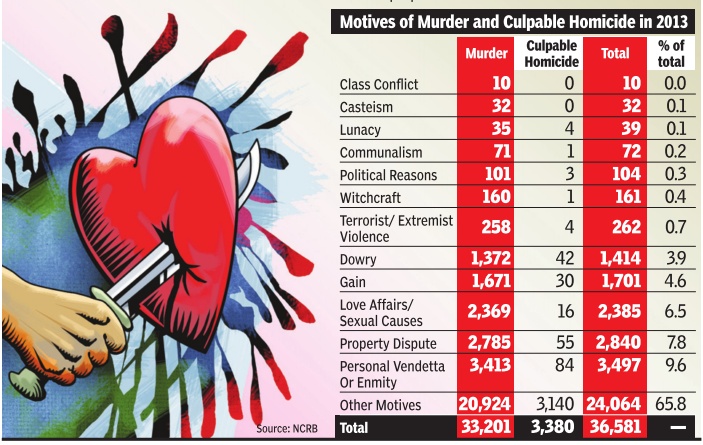
The Times of India Nov 17 2014
Personal vendetta, love affairs and property disputes are the leading causes of murders in India. In 2013, the country witnessed more than 30,000 cases of murder and over 3,000 of culpable homicide not amounting to murder (CH).Investigating agencies identified 12 main motives for these crimes, between them accounting for 35% of all murders and CH. It is surprising to note that even in the 21st century, witchcraft is the reason for over a hundred deaths while communal and caste-related clashes have killed another hundred people
Hasnain Warekar, 35, a chartered accountant from Kasarwadavli, Thane, slit the throats of 14 members of his family, including seven children, in the wee hours of February 27 and then committed suicide. What was wrong with him is still unclear.
In Kolkata this January, Jessica Fonseca and her 16-year-old twin sons were found dead at their house.Her husband Neilconfessed that he had murdered the trio with dumbbells and a knife. The killings were apparently triggered by financial distress.
When police raided the house of Shyam Bahadur Verma, 33, in Surat, on January 24, they found his wife Kirandevi, 30, cut into pieces. Verma had allegedly slit her throat after a quarrel and then cut off her head and limbs. The remains were then chopped into pieces and some bits dropped into a rivulet nearby.
After a stray dog carried a piece of human limb to police officers in Khaderpet in Warangal, Telangana, the bodies of 14-year-old tribal girls Banothu Priyanka and Banothu Bhoomika were recovered. Their bodies were found chopped to pieces in a forest, 25 kms from their native place.
Ashish Kumar, 27, slit his girlfriend’s throat after a stroll at a tea-estate and then clicked a selfie with her. Police say he suspected the girl was having affairs with other men. He uploaded the dead girl’s photo as his display picture on Whatsapp. A headless female body was found in a dustbin in a Chennai suburb. The police discovered it belonged to small-time actress Sasirekha after her husband admitted to killing her and then dumping her severed head in a canal and her torso in a bin.
A merchant navy seaman murdered his wife and her lover. Dhruv Kant Thakur, 29, had a verbal spat with his wife and her lover at her place. In a fit of rage, he killed the man with a knife and then went on to smother his wife with a pillow.
Gurmeet Kaur, a resident of Hoshiarpur, Punjab, admitted to bludgeoning her four-year-old son against the train wall and throwing the body out of the train. She said she had no affection for the child and killed him on her way to Delhi.
A man in Shivamogga city in Karnataka attempted to kill one of his daughters while she was asleep. The reason: she was in love with a taxi-driver from another caste. However, she was not the one who died as the father inadvertently stabbed her younger sister, who was 16 years old.
A gynaecologist at a district hospital in Rampur in eastern UP killed a baby by severing its head while aiding a woman in child delivery. The doctor is said to have used a rope to pull out the baby when its leg first emerged. The infant’s head was then surgically removed and its body discarded in a bin.
Naveen Khatri of north-west Delhi took his girlfriend Arzoo Singh, 23, on a ride out of town, strangled her with a dupatta, brought the body back in his car and stuffed it in a ventilation shaft from where it was recovered four days later.
And 20% in Delhi, 2018 over trivial issues
30th September 2018: The Indian Express
20 per cent of killings in Delhi this year was due to fights over trivial issues: Police data
According to a recent Delhi Police data, 62 of the 337 killings reported till September 15 this year in Delhi took place due to sudden provocation over trivial issues.
Nearly one-fifth of killings reported in the national capital this year could be attributed to fights over trivial issues, such as an accidental brushing-of-shoulder or inability to serve cold water, making them second most common cause of fatal incidents here, according to police data.
Experts believe that sedentary lifestyle, emotional instability and poor social communication maybe reason behind spurt in such cases.
According to a recent Delhi Police data, 62 of the 337 killings (or 18.39 per cent) reported till September 15 this year in Delhi took place due to sudden provocation over trivial issues.
According to the data, personal enmity continues to remain as the most common motive behind murders.
During the last two years, too, personal animosity occupied the top place, followed by violence over sudden provocations or trivial issues.
As per the Delhi police data, 93 out of the 487 cases reported last year were related to sudden provocation.
421 of these reported cases were worked out, the police data shows.
In 2016, 88 out of the 528 killings reported were due to sudden provocation.
Out of the 528 murder cases registered, 409 were solved.
Out of the 337 killings reported till September 15 this year, 65 were over personal enmity and 44 cases were due to family dispute.
In September, a man was beaten to death allegedly by his former employer after he refused to fill water for him from the tanker in outer Delhi's Ranhola area.
In August, a 26-year-old man was beaten to death by another man after an altercation over the victim's shoulder touching his while they were crossing a road in outer Delhi's Nangloi.
In another incident, A 26-year-old man was stabbed to death by three persons including a juvenile following an argument over Rs 500 which he had lent to one of the accused in east Delhi's Kalyanpuri.
"Very small issues are triggering fights between people leading to bloodshed. Recently, there was a case where a helper of a bus killed the driver after the latter refused to return his phone which he had borrowed in northwest Delhi," said an investigative officer.
The officer feels that pressure of the day-to-day life and growing materialism are also the reason behind such incidents.
In July, a 20-year-old man was stabbed to death in front of his wife by one of his friends following a quarrel over serving cold water.
Sudden provocation over trivial issues often lead to sudden anger outburst and sometimes killings, an AIIMS doctor said.
"Such a behaviour of a person could be based on multiple factors including sedentary lifestyle, poor social communication, maladjustment with changing socioeconomic situations in family, use of alcohol and drugs, underlying depression, emotionally unstable brain and poor dietary intake," said Dr Nand Kumar, Physiatrist, AIIMS said.
"In most of the cases, poor mental health leads to poor decision-making capacity and also contributes to sudden provocation, whereas in some cases, anti-social personality trait, depression, paranoia can also result in abrupt and sudden action which could lead to violence," he added.
Judicial pronouncements
'Body of victim not essential to prove murder': Courts
The Times of India, Aug 31 2015
Swati Deshpande
Courts have ruled if there is proof, body of victim not essential to prove murder
For a crime so cruel that has left the nation transfixed in horror, judicial precedents show that absence of a dead body or failure to identify its charred remnants does not prevent prosecution and even conviction, if compelling circumstantial evidence proves a murder had taken place.
Corpus delicti, a Latin term used to describe the body or foundation of a crime and in popular criminal law jargon, “the body of the murder victim, is not an essential requirement to prove a murder, courts have ruled. Leading criminal law counsel, Amit De sai, said, “If there is compelling evidence of murder, absence of dead body can't prevent conviction. He added, “There is the last seen concept and other circumstances, besides direct evidence and admissible confession, that could play a role in gathering up a body of evidence. Another defence lawyer, Aabad Ponda, said, “Corpus delicti is not mandatory to get a conviction, even in its absence murder can be proved on the basis of strong circumstantial evidence. The Supreme Court has in several rulings in cases dating back to the 1950s cited English court judgments to lay down that lack of a dead body would not allow a person accused of murder to escape unpunished.
Justice M Hidayatullah, up holding a murder conviction in 1959 in the then State of Bom bay, had quoted a British ruling that enunciated the legal principle. “At the trial of a person charged with murder, the fact of death is provable by circumstantial evidence, notwithstanding that neither the body nor any trace of it has been found, and that the accused has made no confession of participation in the crime. Before she can be convicted, the fact of death should be proved... beyond reasonable doubt... “Circumstantial evidence in this context means combination of facts creating a network through which there is no escape for the accused, said the SC, “because as a whole they infer only to guilt.“
The SC bench of Justices P Sathasivam and B S Chauhan held in 2011 (Prithipal Singh vs State of Punjab) that “in a murder case, it is not necessary that the dead body should be found and identified, ie, conviction for murder does not depend on corpus delicti being found... It said, “Conviction can be based on uncorroborated testimony of the accomplice and the “court may act on the testimony of a sole eye-witness, if found reliable.
Mass murderers
1960s-2017: some prominent cases

From January 3, 2018: The Times of India
See graphic :
1960s-2017: some prominent mass murderers
Delhi’s serial killers
Naresh Dhankar’s murderous rampage on Tuesday shocked the residents of the National Capital Territory. But serial killings are not new in the region. People readily recall the Nithari killings, but there were others, equally gruesome and equally inexplicable.
Among the NCR’s serial killers is Rinku, who was apprehended three years ago in Faridabad. The rickshaw puller had killed at least eight by the time of his arrest. He lived in south-east Delhi from 2009 to 2012, but later shifted to SGM Nagar in Faridabad where he stayed with his sister.
Late at night, Rinku would strangle his passenger, using a new gamchha each time. While five of the murders were reported in Faridabad, three took place in Delhi, including a man in Mansarovar Park in 2011and in Nand Nagri in 2012. “One of Rinku’s victims whom he had left for dead survived and led the cops to him,” a police officer recalled.
Another cold-blooded killer was Chandrakant Jha, who was arrested in 2007. Every now and then Jha would murder a person, behead the body and dump it near Tihar Jail in west Delhi. The bodies were accompanied by a note boasting that the police would get such gifts every fortnight.
Jha’s father worked with the Bihar government and his mother was a school teacher there. He was first arrested in 1998 for killing his friend who had lied to him. After remaining in jail for three years, Jha came out in 2002 — more deadly and dangerous.
Jha was sentenced to death in three of the Tihar Jail cases. However, the court commuted the capital punishment to life sentence in 2016. Lodged in Jail No 9 at Tihar as a highrisk convict, Jha today mostly keeps to himself, refusing to participate in jail activities. He has, however, been on his best behaviour. He has no visitors ever since his wife, Mamta, stopped going to meet him a few years ago.
The notorious Devender Sharma is the NCR’s doctor of doom. After completing his Bachelor’s degree in Ayurvedic Medicine and Surgery, Sharma practised medicine in his hometown of Aligarh in UP before setting out on his macabre career. Sharma would pose as a tourist and hire long-distance cabs. On the way, he would kill the taxi drivers, steal their vehicles and sell them.
Sharma bumped off 30 drivers from Delhi, Gurgaon and UP between 2002 and 2004, three of them from the capital. He was arrested in 2005, and was sentenced to death in 2008. Lodged in Bhondsi Jail near Gurgaon, Sharma is awaiting his turn at the gallows.
Among NCR’s infamous serial killers were Rinku, who was apprehended three years ago in Faridabad; Chandrakant Jha, who was arrested in 2007; and Devender Sharma who was sentenced to death in three cases
Rate of murder
1957-2015
See graphic:
Murders and culpable homicide per million per year, 1957-2015
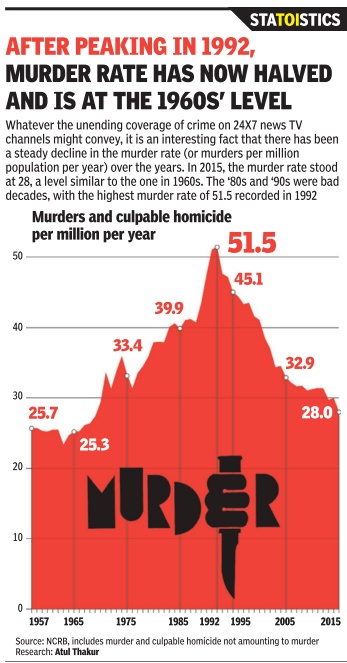
1957-2016
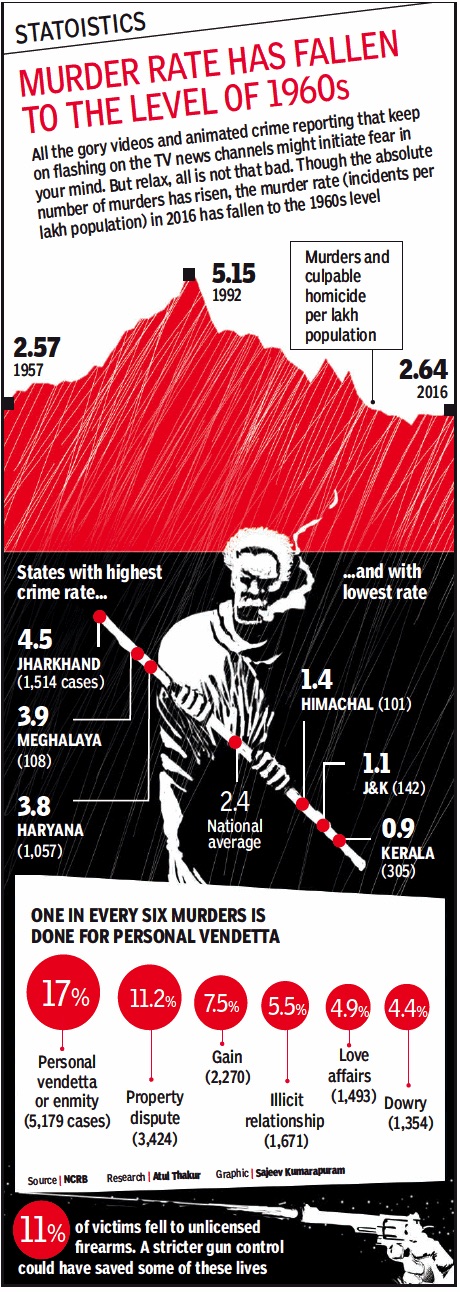
From December 8, 2017: The Times of India
See graphic:
Murders and culpable homicide per million per year, 1957-2016
1957-2017
Atul Thakur , Oct 23, 2019: The Times of India

From: Atul Thakur , Oct 23, 2019: The Times of India
The murder rate in India in 2017 was the lowest it has been in the last 54 years. In fact, with the exception of 1963, it has never been lower since 1957, the earliest year for which data on this rate is available.
The just released Crime in India 2017, a publication of the National Crime Records Bureau (NCRB), put the murder rate (including culpable homicide) for the year at 2.49 per lakh population. Barring 1963, when it had touched 2.34, it has always been higher, peaking at 5.15 in 1992 before dropping steadily to its current level.
Although overall crime rates have increased over the years, there has been a steady decline in the murder rate (incidents per lakh population) and they have in recent years been at the lowest levels since the 1950s. Even globally, murder rates have been on the decline in almost every country in recent decades. Prior to the most recent period, the 14 years between 1957 and 1970 were the least violent in terms of murder and culpable homicides, with less than three incidents reported for every lakh of population.
From the 1970s, the rate started increasing to reach its peak in 1992, about 75% higher than in the 1950s. Murders also peaked in absolute numbers in that year
UP and Bihar top NCRB murder chart
Murders in India peaked in absolute numbers in 1992 and have been falling since then, dropping to below 3 per lakh starting with 2013. At the peak in 1992, UP witnessed 12,287 incidents of murder and culpable homicide not amounting to murder, the highest in the country. It was followed by Bihar (5,743), Madhya Pradesh (3,753), Maharashtra (3,338) and Andhra Pradesh (2,841). Despite the populations of these states having increased several fold since then, murder and culpable homicides have declined even in absolute terms in all of them.
Traditional theories of criminal justice — crime being linked to economic instability and capital punishment acting as a deterrent to violent crime — have failed to explain this global trend of falling murder rates as they have declined despite turbulent economic conditions and capital punishment increasingly being discarded.
1995-2016: in India, other countries
August 8, 2019: The Times of India

From: August 8, 2019: The Times of India
See graphic:
1995-2016: murder rates in India, Brazil, China, Colombia, Germany, Japan, Russia, South Africa, the UK and the USA
Experts say economic stability and stiff punishments reduce violent crime, but murder rates have fallen across the world since the 1990s despite economic turbulence and fewer death sentences. Alternative explanations for the trend range from a ban on leaded petrol to legalisation of abortion, but there is no consensus on them.
2008-15
See graphic:
Some famous murders in India, 2008-15.
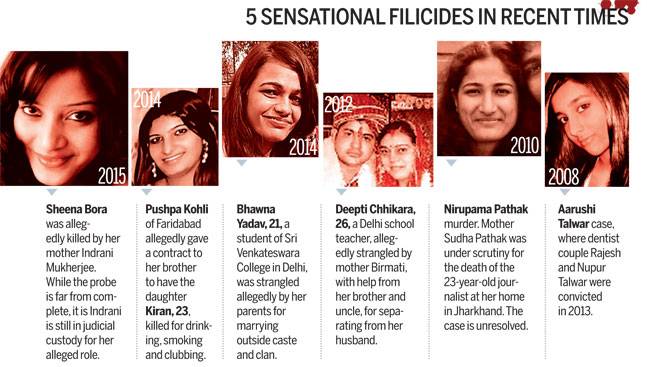
2014: Lowest rate since 1960s
Source:
1. The Times of India, Aug 23 2015
2. The Times of India, Aug 23 2015
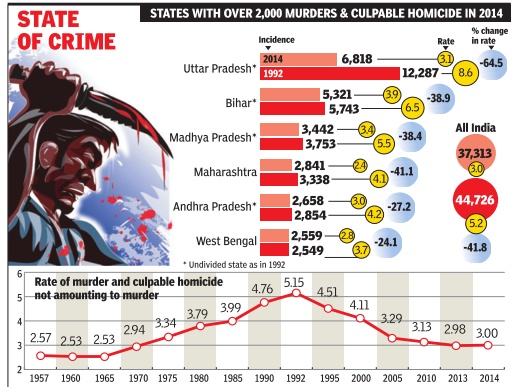
Atul Thakur
Murder count in India falls to its lowest level since 1960s
Fewer murders belie dystopian fears
The murder rate in India in the past few years has been at its lowest level since the 1960s. Even the absolute number of murders in 2014 was lower than in 1992, the year when the murder rate (number of murders per lakh of population) was at its highest.
The counter-intuitive fact emerges from an analysis of data from the National Crime Records Bureau's (NCRB) annual publication, Crime in India. In 2014, the country witnessed 33,981 murders and 3,332 incidents of culpable homicide not amounting to murder.The combined rate of the two crimes per lakh of population was 3.0 in 2014 and 2.98 in the previous year. A lower rate was last recorded in 1970, when 16,180 murders and 2,357 culpable homicides amounted to a combined rate of 2.94.
While NCRB has data on the absolute number of murders from 1952, it has been reporting the rate from 1957. It shows the rate started increasing from the mid-60s to reach its peak in 1992 when the combined rate was 5.15, roughly double the level in 1957. Since 1992, it has been falling rather steadily. The state-wise compari son of the data for 1992, the peak year, and 2014 shows that murder rates (number of murders per lakh of population) have decreased in 26 of the 32 states and UTs that existed at that time. (To make the data comparable, 2014 figures of Andhra Pradesh & Telangana, Bihar & Jharkhand, Uttar Pradesh & Uttarakhand, Madhya Pradesh and Chhattisgarh have been clubbed together).
In 1992, Uttar Pradesh witnessed 12,287 incidents of murder and culpable homicide not amounting to murder. It was followed by Bihar (5,743), Madhya Pradesh (3,753), Maharashtra (3,338) and Andhra (2841). Although the order is the same in 2014, all of these states have seen the absolute number of incidents dropping.Uttar Pradesh and Uttarakhand put together had 6,818 incidents, while for undivided Bihar and Madhya Pradesh, the number of incidents was 5,321 and 3,442 respectively. Similarly Maharashtra and undivided Andhra also saw a decline.
In the past two decades, the population of all states has gone up by several millions and therefore the rate of incidents has dropped significantly , in some cases to less than half their 1992 levels. It is not clear why the murder rate first in creased rapidly and then has dropped equally sharply , but what is clear is that impressionistic ideas of society getting increasingly violent may need to be revisited.
2015: Murders, state-wise
The Times of India, Sep 01 2016
Dipak Kumar Dash & Pervez Iqbal Siddiqui
Uttar Pradesh had 68% share of the total number of honour killings reported in 2015, the latest report of the National Crime Records Bureau (NCRB) says. The abnormal increase in the number of such cases from one in 2014 to 131 in 2015 has stumped many .
The NCRB report released reported a seven-fold rise in honour killing cases in 2015, Uttar Pradesh registering the largest number. Gujarat and Madhya Pradesh followed.
Honour killing as a separate segment was introduced in the NCRB report in 2014.
Similarly, UP registered steep rise in political murders --from two in 2014 to 28 last year. Jharkhand, Kerala and MP came second, third and fourth in political killings in 2015. Last year 96 political killings were registered across the country against 64 the previous year.
On the stunning rise in honour killings, an NCRB source said: “Whenever we notice an abnormal spike in cases, we get them verified with the state crime records bureau before publishing them. This procedure was followed even in the case of Uttar Pradesh.“ Senior state police officers told TOI that the sharp rise in honour killings could be because of better public awareness. Registration of such cases may rise even further because social media use is becoming popular even in the hinterland.
UP DGP Javeed Ahmed said honour killing was a social crime and believed stringent police action could act as a deterrent to some extent. “But, it is about creating awareness that such killings aren't a solution to complex social issues,“ he said. Former Lucknow University vice-chancellor Roop Rekha Verma refused to accept that only one honour killing took place in UP in 2014. Many such crimes were not even reported, believes Verma.
“People have now started reporting such crimes. Earlier these were lumped with just other murders,“ said Madhu Garg, state general secretary of All India Democratic Women's Association.
The NCRB report also showed an increase in murders resulting from love affairs and illicit relationships.
2015: Pakistan worst, Nepal best in S.Asia
See graphic:
The Rate of murder in Bangladesh, India, Nepal, Pakistan, Sri Lanka, and other major countries
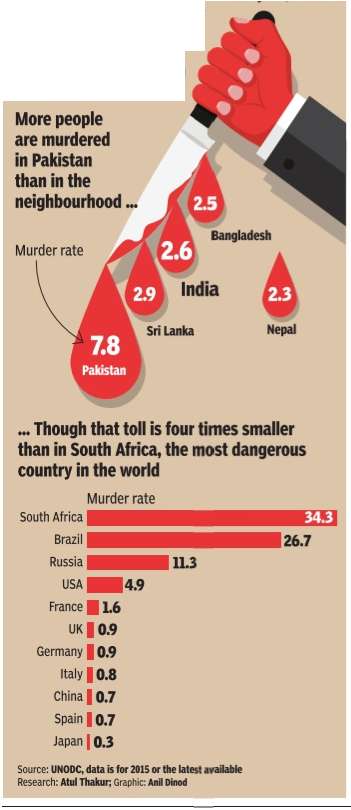
From: October 31, 2017: The Times of India
Road rage murders
2016: 95% of road rage murders took place in UP
Uttar Pradesh’s reputation of being a lawless land suffered another dent with NCRB data pointing to it being home to the most hotheads on the road.
Out of 4,889 murders in the state in 2016, almost 10% (489 murders) were blamed on road rage, shows the annual crime data compiled by National Crime Records Bureau (NCRB).
Interestingly, 513 murders were reported in 29 states and 7 Union Territories in which the motive of murders was registered as ‘road rage’, which means 95% of all such murders were committed in UP.
In all, 30,450 murders were committed across the country in 2016 and UP reported the most cases of homicides. Thirteen road rage murders were reported from Maharashtra, three from Gujarat, two each from Manipur and Chhattisgarh and one each from Karnataka, Kerala, Madhya Pradesh and Delhi.
The NCRB, however, says that this road rage data provided by UP government is under clarification.
Till 2015, road rage incidents were recorded by NCRB under the head rash driving/road rage, linking it to incidents which have happened while driving. It is for the first time NCRB has listed a separate ‘road rage’ head for motive of murders.
According to NCRB’s 2015 annual report, road rage data was used only for number of cases “causing injuries under rash driving/ road rage” in which states like Kerala, Tamil Nadu, Madhya Pradesh, Karnataka and Maharashtra topped the figures. In 2015, overall cases of road rage and rash driving in the country amounted to 4,51,069. However, this year, 3,48,914 cases where people received injuries due to rash driving have been reported delinking it from road rage.
According to NCRB’s 2016 data, murders due to caste conflict have come down in the country from 828 incidents in 2015 to 134 in 2016. There is a slight increase in political murders — from 96 in 2015 to 113 in 2016, while Naxalism claimed 327 lives.
Unsolved murders
2015, High-profile unsolved murders
See graphics:
Narendra Dabholkar murder case
Satish Shetty murder case
Sarla Mishra murder case
K. N. Ramajayam murder case
Govind Pansare, Akanksha Rathi and Sukumara Kurup murder cases



